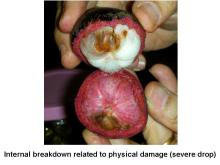Maturity and Quality
Skin color change to reddish-purple is the primary maturity index for mangosteen. The fruit has a persistent calyx at the stem end and is picked with the peduncle attached. The aril (pulp) separates from the rind in ripe fruit.
- Fruit size
- Shape
- Color
- Freedom from defects (skin cracks and blemishes, latex staining, insect damage)
The inedible pericarp is hard and the edible pulp is white, soft, juicy, and consists of 5 to 8 segments (similar to citrus fruits). Soluble solids content ranges from 17 to 20% and titratable acidity ranges from 0.7 to 0.8% (pH = 4.5 to 5.0).
Postharvest Handling and Storage
13 ± 1°C (56 ± 2 °F), storage potential = 2-4 weeks, depending on cultivar and ripeness stage.
6-10 ml CO2/kg·hr at 20°C (68°F); climacteric respiratory pattern.
To calculate heat production multiply ml CO2/kg·hr by 440 to get Btu/ton/day or by 122 to get kcal/metric ton/day.
Exposure to 100 ppm ethylene for 24 hours at 20°C (68°F) accelerates ripening (color change to dark purple and softening of the pulp).
90-95%
3-30 µl C2H4/kg·hr at 20°C (68°F)
Disorders
Chilling Injury. Symptoms include darkening and hardening of the skin and increased susceptibility to decay when the fruit is moved to higher temperatures following storage at less than 10°C (50°F) for longer than 15 days or at 5°C (41°F) for more than 5 days.
Translucent Flesh. Symptoms are internal and include flesh changes from white to translucent and textural changes from soft to firm and crisp. This disorder may result from mechanical injuries, nutrient imbalance, and/or excessive water uptake into the flesh.
Rind Hardening. Mechanical damage (compression or impact bruising) to the fruit during harvesting and handling often results in hardening of the rind, which may be combined with hardening and translucency of the pulp (one or more segments).
Decay may be caused by Botryodiplodia theobromae, Diplodia spp., Pestalotia flagisettula, Phomopsis spp., or Rhizopus spp.









